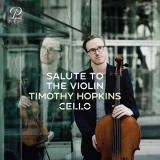Der ist doch verrückt, mag denken, wer liest, dass der deutsch-amerikanische Cellist Timothy Hopkins ikonische Violinwerke auf dem Cello spielt. Und dazu noch solche, die für ihre technisch herausfordernde Kompositionsart gefürchtet sind. Neben dem letzten Caprice von Paganini ist dies Introduction & Rondo capriccioso von Saint-Saëns. Kann das auf dem Cello überhaupt gutgehen? Doch auch die Chaconne von Bach und die Sonate von César Franck gehören zu diesen Juwelen der Violinliteratur, deren Schwierigkeiten gleichzeitig auch noch in der Interpretation zu meistern sind.
Dass die Sonate nun schon wiederholt in einer Cellofassung erklingt, zeigt, dass dieses Werk die Cellisten anregt und gerade auch für dieses Instrument ihren Charme entfalten kann. Der gegenüber der Geige vollere und damit sonorere Klang kommt der Stimmung des Werkes sehr entgegen. Gerade bei diesem Stück mag mancher sich am Celloklang sogar mehr erfreuen als am Original des höheren Streichinstruments. Jedenfalls gelingt es Hopkins, die außerordentlich farbenreiche Harmonik des Werkes nuanciert heraus zu kitzeln.
Hopkins hat für Bach seine Version verwendet, die weitgehend nur nach unten oktaviert am Original bleibt, also mehr eine Umschreibung der Fingersätze als ein Arrangement. Ansonsten hat er andere Bearbeitungen umgesetzt, die er punktuell mit eigenen oder fremden Gedanken wiederum abgewandelt hat.
Obwohl die Stücke des Glanzes des Klangs der hohen Violinsaiten beraubt sind, gewinnen sie beim Cello mit der dunkleren Färbung eine neue Intensität, die ihnen zugutekommt. Zu Anfang scheint man zu hören, dass Hopkins die Stücke langsamer spielt als ein Geiger es tun würde, um so dem größeren und damit mutmaßlich schwerer schnell zu spielenden tieferen Streichinstrument Genüge zu tun. Aber in absoluten Spielzeiten bleibt er im Rahmen des Üblichen. Und das beweist, dass er sein Instrument so elegant und zügig zu spielen versteht, dass auch das Cello behände und leicht jubilieren kann. Die Momente, in denen es doch ein wenig beharrlich klingt, sind rar.
Die in Tomsk geborene Pianistin Vita Kan ist dank ihrer langjährigen Freundschaft mit Hopkins eine gewandte Begleiterin, die einen feinen Dialog mit dem Cellisten führt. So bieten die beiden Musiker eine spannende Reise mit den neuen tieferen Höreindrücken.
He’s crazy, you might think who reads that German-American cellist Timothy Hopkins plays iconic violin works on the cello. And on top of that, those that are feared for their technically challenging compositional style. In addition to the last Caprice by Paganini, this is Introduction & Rondo capriccioso by Saint-Saens. Can this even go well on the cello? But also the Chaconne by Bach and the Sonata by César Franck belong to these jewels of violin literature, whose difficulties have to be mastered in interpretation at the same time.
The fact that the sonata is now repeatedly heard in a cello version shows that this work stimulates cellists and can develop its charm especially for this instrument. The fuller and thus more sonorous sound compared to the violin is very much in keeping with the mood of the work. In this piece in particular, some may even enjoy the cello sound more than the original of the higher string instrument. In any case, Hopkins succeeds in tickling out the extraordinarily colorful harmonics of the work with nuance.
Hopkins has used his version for Bach, which remains largely only octavated downwards to the original, thus more a rewriting of the fingerings than an arrangement. Otherwise, he took other arrangements, which he has in turn modified at points with his own or others’ thoughts.
Although the pieces are deprived of the brilliance of the sound of the high violin strings, they gain a new intensity from the cello with the darker coloring that benefits them. At the outset, one seems to hear Hopkins playing the pieces more slowly than a violinist would, in order to accommodate the larger, and thus presumably harder to play fast, lower string instrument. But in absolute playing times, he stays within the bounds of the usual. And this proves that he knows how to play his instrument so elegantly and swiftly that even the cello can jubilate nimbly and easily. The moments when it does sound a little insistent are rare.
Tomsk-born pianist Vita Kan, thanks to her long friendship with Hopkins, is a deft accompanist who carries on a fine dialogue with the cellist. Thus, the two musicians offer an exciting journey with the new deeper listening impressions.
























